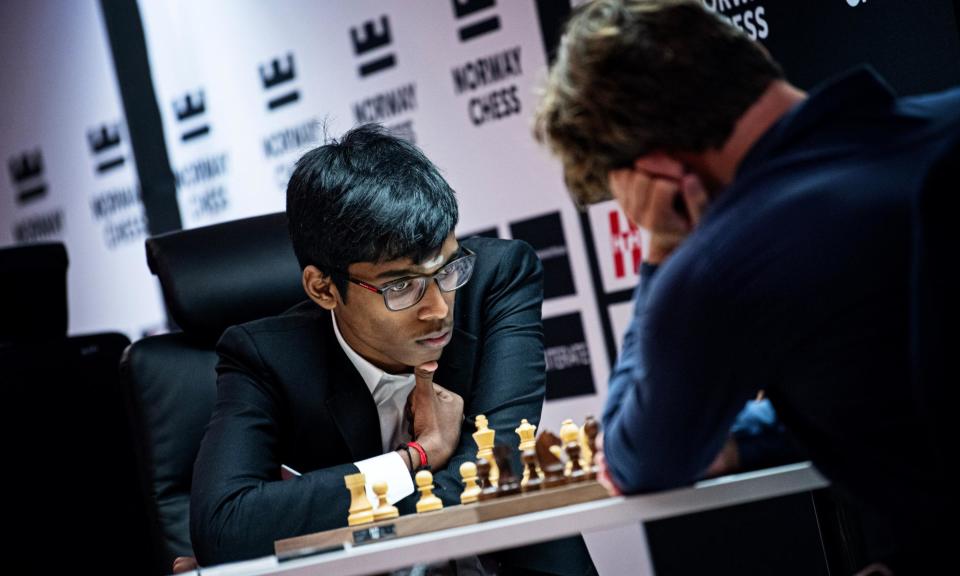Chess: Magnus Carlsen loses on home turf in Norway to 18-year-old Indian

The world No 1, Magnus Carlsen, has been the dominant performer in recent years in Norway Chess, the elite tournament played annually at Stavanger. From 2019 to 2022 he won it four times a row, before a setback in 2023. Coming into the 2024 event with eight victories in nine tournaments, he was the strong favourite.
Wednesday’s third round was off script. Carlsen not only lost to India’s rising 18-year-old star Praggnanandhaa Rameshbabu, he was comprehensively outplayed in a 1 e4 c5 Sicilian which the teenager controlled with his centralised d5 knight.
Praggnanandhaa said later: “I now have enough experience at this level and can beat the top players, but I have to play my best for that, and that’s what I’m trying to do. That’s the mindset.”
Carlsen’s rigid pawn formation allowed White to advance f4-f5 and force the weakening …e6-e5, and his passive 13…Qd7? was a key error. Given his opportunity, Praggnanandhaa manoeuvred subtly, exploiting Black’s inability to castle and eventually breaking through on the b file. The game is classically clear, and sure to feature in textbooks for decades to come.
Fabiano Caruana caught the world champion, Ding Liren, with the prepared novelty 13 a4! in one of the Chinese GM’s favourite variations of the Italian Game. Ding defended well for a while, but got behind on the clock and his blunder 25…Qc6? (Rg8!) allowed the winning sacrifice 26 Nxg7! after which the black king became fatally exposed.
The tournament has special rules which have helped Carlsen, who in the Stavanger events a decade ago won in only one year out of six. Draws are now replayed as Armageddons, where White has 10 minutes on the clock to Black’s seven minutes, but a draw on the board counts as a win for Black on the scoreboard.
The scoring is 3 points for a classical win, 1.5 for a classical draw and an Armageddon win, 1 for a classical draw and an Armageddon loss, 0 for a classical loss. Carlsen has developed winning at Armageddon to a fine art and since 2019 has a near 80% success rate with both colours in these games.
In the opening round, Carlsen and Ding drew their classical game quickly by threefold repetition. Their Armageddon game looked strange, and took 65 moves, but Carlsen, playing Black, had his route to the desired draw planned out far ahead.
In a blocked position, he regrouped his f6 knight via h7, f8, and e6 to d4. Then he eliminated all the bishops and knights, leaving kings, queens, rooks and eight pawns each. Ding was behind on the clock, so was obliged to open up the game and simplify to a queen and pawn ending, where Carlsen forced a draw by perpetual check.
Job done, 1.5 points for Carlsen, who will surely want to prove his superiority over his successor as world champion and aim for the full 3 when he plays White against Ding in their return game on Sunday (4pm BST start, live on lichess). That should be an occasion to watch. By then, it should also be clear whether Ding’s declared ambition for the tournament, not to finish last, was too modest.
However, successive defeats in rounds three and four have dropped Ding to the bottom of the table, so that Stavanger is already developing ominously for the world champion.
In Thursday’s fourth round all three classical games were decisive. Caruana lost to Carlsen, Hikaru Nakamura beat Praggnanandhaa to take the overall lead, while Alireza Firouzja beat Ding.
Scores after four rounds: Nakamura (US) 7, Firouzja (France) 6.5, Carlsen (Norway) 6, Praggnanandhaa (India) 5.5, Caruana (US) 5, Ding (China) 2.5.
Ding will defend his world crown in November-December in a 14-game series against India’s Gukesh Dommaraju, who celebrated his 18th birthday this week. The 31-year-old will play at least two more tournaments before the match, the 180-nation Olympiad at Budapest in July and the Sinquefield Cup at St Louis in August. Thus he will hope to start his world championship defence in good shape, and to take advantage of his teenage opponent’s lack of experience at the very highest level.
Related: Chess: Carlsen wins in Casablanca as new variant tests historic skills
Norway Chess has also introduced a major innovation this year with a six-player women’s elite invitational staged alongside the open event. The prize funds of $160,000 are identical, which means the new tournament is the second richest all-female event on the calendar, surpassed only by the $200,000 for next month’s Cairns Cup at St Louis. The intention of both Stavanger and St Louis is to create a viable women’s professional tour which will encourage more full-time female players.
After four rounds of Women’s Norway Chess, Vaishali Rameshbabu led with 8.5 points, ahead of the women’s world champion, China’s Ju Wenjun, on 6. The 22-year-old sister of Praggnanandhaa already made her mark at the Candidates in Toronto by surging from last place to tied second, winning her last five games. At Stavanger, she scored a landmark victory in the classical game against India’s longtime No 1 woman, Humpy Koneru.
Women’s Norway Chess after four rounds: Vaishali (India) 8.5, Ju (China) and Anna Muzychuk (Ukraine) 6; Lei Tingjie (China) 5; Koneru (India) and Pia Cramling (Sweden) 3.
Friday is a rest day in both tournaments.
3922: 1...Qd2+ 2 Ka3 Qc1+ 3 Kxa4 Qa1+ 4 Kb4 Qb1+ 5 Ka5 Qa2+ 6 Kb6 Qxe6+ and wins.
